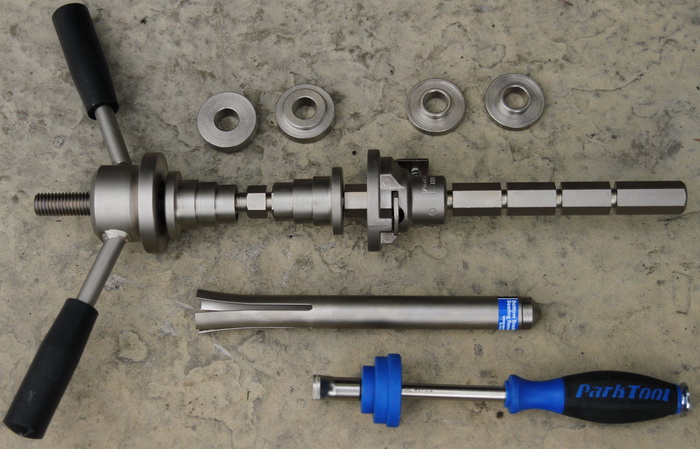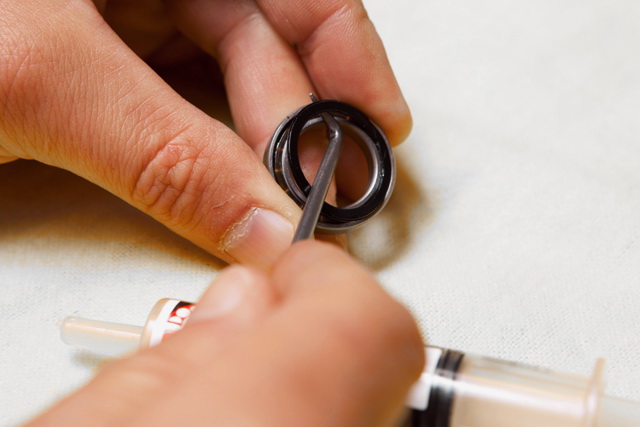Bottom bracket service falls into one of two categories: you either change them with a new one or exchange bearings. Older square tapered bottom brackets with loose ball bearings were full service, but nowadays that’s rare. You could (if you’re careful) repack a non-sealed cartridge (external BB) bearing, but it is not advisable (so saith the Park bible) . Other brands do sell replacement bearings or seals to get the job done.
Bikes with threadless bottom brackets (PF30 or similar) require you to punch out your old bearings using a BBT 30.3 or BBT 90.3 tool and a press HHP-2 or HHP-3 for installation. Those tools will run you about $130-250 in total (depending whether or not you go for the HHP-2). These type of bearings require the use of the BBT 30.3 or BBT 90.3 to contact the inside of the opposite bearing and have them struck out with the aid of a hammer on the tool. Once struck, they are replace only. Servicing them may be possible only if the design has the bearing seals exposed.
Full one piece sealed cartridge style bottom brackets (octalink,square taper) are simply replace only. Depending on which sealed cartridge you have, you would need the appropriate tool to remove and replace them.
Bearing Reconditioning
Note: Remember, bearings are a wear item. The following procedures may or may not work depending on the age of your bike and the amount of contamination that your bike has been put through. I only recommend the following reconditioning procedures for bearings that have their seals exposed.
If your intent is to repack an existing sealed bearing you will need to clean out the old grease, remove all contaminants, and then repack the bearing with synthetic waterproof grease. Removing the bearing from the bottom bracket cups could damage them to the point of no return and require replacement. That said, check the present condition of your bearings by rotating them. If the bearing feels very crunchy then you pretty much need a new bearing; no amount of cleaning will bring it back to a serviceable state. If the bearing is feeling just a bit rough, you might be able to save it.
With external cartridge bottom bracket bearings, you’ll need to get to the side seals and remove the exposed side. Before that work, I remove the whole bearing cup with bearing from the bike. That way I can place the whole item in my parts washer and give it a good cleaning. Press fit bearings, on the other hand, I would keep in the frame. Press fit bearings will more than likely be damaged by trying to remove them. So leave them be… unless you’re replacing them.
Some manufacturers, Such as Shimano and Raceface, include a dust cover that has to come off first. If you’re very cheap or tight on time, you can attempt to remove the cover, but there is a 60% chance they may crack. There is a small ridge of plastic that holds that cover in place.
You would have to be very careful to remove the cover successfully. Fashion a dowel with a very sharp edge or use a socket (if you have one) to carefully push that cover out of the way (this is why Park says it’s not recommended to do this).
Raceface does sell new outer race seals as replacement pieces. Replacement bearing kits cost about $20-40 for those manufacturers that sell them, and new bottom brackets from Shimano start at about $25 and go up from there.
To remove the side seal on a bearing, use a pick-like tool. I use a set of Snap-On picks that I flatten just a bit. That gives me more of a wedge rather than a spike end. Using the pick, carefully fit it in the space between the seal and the inner race. Gently pry the seal until it begins to come out. Then glide the pick around the edge of the bearing, all the while fitting the pick in behind the seal to encourage it to come out. It should be easy and require little effort.
Once the seal is removed, begin to clean the old grease out. I use a mild solvent and WD40… believe it or not, the WD40 does a great job at displacing the built up water and rust.
Have any old tooth brushes handy? If so, use a tooth brush to scrub the race and balls in the bearing. I work at it until a squirt of WD40 comes out clean. Check your work by spinning the bearing and feeling for grit. The bearing should feel smooth. If it doesn’t, double check for chipped or discolored balls (indications that things are not well, and replacement is necessary). If the bearings are all good, I use fresh grease and repack everything. Add grease in the space between the bearings and rotate the bearing slowly to evenly spread the grease. I go a bit overboard here. Once the bearing is packed, simply re-install the seal.
Before installing the new or repacked external bearing cups back into the frame, check the threads of the bottom bracket from the frame. While you are there, also inspect the facing. Some (not all) manufacturers forget to face the ends of the frame. If that is the case, the cranks will not fully contact the bearings and they will wear out prematurely.
I personally have a SuperB facing tool for this task (which is the same as Park’s BTS-1, just half the cost). Most people won’t. Your local bike shop will, though. If you see that the bottom bracket cup leaves a small gap on one end of the frame when you’re tightening things up, then you’re going to have to have that repaired.
At the shop, they firstly measure the bottom bracket spacing (e13 and Raceface require perfect spacing for things to work properly). Then, they insert a set of threaded guides into the bottom bracket, or if the threads are really bad, a tap is run through to clean things up. A facing tool carefully removes a bit of material until the cutter has full contact with the bottom bracket shell. It is important not to go crazy here as the width may get too narrow for the cranks to work properly Always refer to the literature supplied by the bottom bracket manufacturer. This procedure ensures the parallelism of your bearing cups, extending the life of both the bearings and your crank arms. It also eliminates that annoying cracking sound that sometimes occurs under power.
For threadless bottom brackets (PF30, BB30, BB86,92 or 95) a headset press and the BBT 30.3 or 90.3 tool is required to press the bearings in. Before pressing these in, you have to inspect the bore for any burs or nicks in the shell.
It may be prudent to test the fit of your Press Fit cups. If a bearing slides into the bore, or you have already had creaking issues, then you will need to apply a retaining compound like Loctite RC609 on the bearings or PF adapter cups. If all is good there, then you can install your bearings using the adapter for your particular BB and a headset press. Keep in mind that these have to be installed dead straight into your bottom bracket shell. Apply just a small amount of torque on the bearings, and make sure they are installing squarely into the frame. Continue if all is straight until the adaptors contact the shell face. Remove your installation tools, and you’re good to install your cranks.
For threaded external bearing cups, apply a fresh bit of grease to the threads of your bottom bracket cups, install any shell spacers, and torque the cups back in place. Refer to the manufacturer’s literature as to how many and where the 2.5mm spacers get installed. Most cups are installed with 40 Nm of torque. Finally, install your cranks.
Click here for information on servicing your cranks.
































